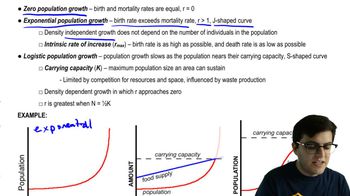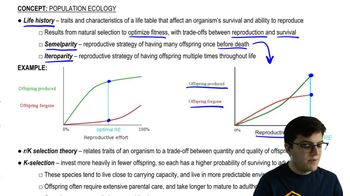Table of contents
- 1. Introduction to Biology2h 40m
- 2. Chemistry3h 40m
- 3. Water1h 26m
- 4. Biomolecules2h 23m
- 5. Cell Components2h 26m
- 6. The Membrane2h 31m
- 7. Energy and Metabolism2h 0m
- 8. Respiration2h 40m
- 9. Photosynthesis2h 49m
- 10. Cell Signaling59m
- 11. Cell Division2h 47m
- 12. Meiosis2h 0m
- 13. Mendelian Genetics4h 41m
- Introduction to Mendel's Experiments7m
- Genotype vs. Phenotype17m
- Punnett Squares13m
- Mendel's Experiments26m
- Mendel's Laws18m
- Monohybrid Crosses16m
- Test Crosses14m
- Dihybrid Crosses20m
- Punnett Square Probability26m
- Incomplete Dominance vs. Codominance20m
- Epistasis7m
- Non-Mendelian Genetics12m
- Pedigrees6m
- Autosomal Inheritance21m
- Sex-Linked Inheritance43m
- X-Inactivation9m
- 14. DNA Synthesis2h 27m
- 15. Gene Expression3h 20m
- 16. Regulation of Expression3h 31m
- Introduction to Regulation of Gene Expression13m
- Prokaryotic Gene Regulation via Operons27m
- The Lac Operon21m
- Glucose's Impact on Lac Operon25m
- The Trp Operon20m
- Review of the Lac Operon & Trp Operon11m
- Introduction to Eukaryotic Gene Regulation9m
- Eukaryotic Chromatin Modifications16m
- Eukaryotic Transcriptional Control22m
- Eukaryotic Post-Transcriptional Regulation28m
- Eukaryotic Post-Translational Regulation13m
- 17. Viruses37m
- 18. Biotechnology2h 58m
- 19. Genomics17m
- 20. Development1h 5m
- 21. Evolution3h 1m
- 22. Evolution of Populations3h 52m
- 23. Speciation1h 37m
- 24. History of Life on Earth2h 6m
- 25. Phylogeny2h 31m
- 26. Prokaryotes4h 59m
- 27. Protists1h 12m
- 28. Plants1h 22m
- 29. Fungi36m
- 30. Overview of Animals34m
- 31. Invertebrates1h 2m
- 32. Vertebrates50m
- 33. Plant Anatomy1h 3m
- 34. Vascular Plant Transport2m
- 35. Soil37m
- 36. Plant Reproduction47m
- 37. Plant Sensation and Response1h 9m
- 38. Animal Form and Function1h 19m
- 39. Digestive System10m
- 40. Circulatory System1h 57m
- 41. Immune System1h 12m
- 42. Osmoregulation and Excretion50m
- 43. Endocrine System4m
- 44. Animal Reproduction2m
- 45. Nervous System55m
- 46. Sensory Systems46m
- 47. Muscle Systems23m
- 48. Ecology3h 11m
- Introduction to Ecology20m
- Biogeography14m
- Earth's Climate Patterns50m
- Introduction to Terrestrial Biomes10m
- Terrestrial Biomes: Near Equator13m
- Terrestrial Biomes: Temperate Regions10m
- Terrestrial Biomes: Northern Regions15m
- Introduction to Aquatic Biomes27m
- Freshwater Aquatic Biomes14m
- Marine Aquatic Biomes13m
- 49. Animal Behavior28m
- 50. Population Ecology3h 41m
- Introduction to Population Ecology28m
- Population Sampling Methods23m
- Life History12m
- Population Demography17m
- Factors Limiting Population Growth14m
- Introduction to Population Growth Models22m
- Linear Population Growth6m
- Exponential Population Growth29m
- Logistic Population Growth32m
- r/K Selection10m
- The Human Population22m
- 51. Community Ecology2h 46m
- Introduction to Community Ecology2m
- Introduction to Community Interactions9m
- Community Interactions: Competition (-/-)38m
- Community Interactions: Exploitation (+/-)23m
- Community Interactions: Mutualism (+/+) & Commensalism (+/0)9m
- Community Structure35m
- Community Dynamics26m
- Geographic Impact on Communities21m
- 52. Ecosystems2h 36m
- 53. Conservation Biology24m
50. Population Ecology
Introduction to Population Ecology
Problem 4a
Textbook Question
A population growing exponentially . a. is stable in size; b. adds a fixed number of individuals every generation; c. adds a larger number of individuals in each successive generation; d. will likely expand forever; e. will not crash
 Verified step by step guidance
Verified step by step guidance1
Understand the concept of exponential growth in populations, which is described by the equation \( N(t) = N_0 e^{rt} \), where \( N(t) \) is the population size at time \( t \), \( N_0 \) is the initial population size, \( r \) is the intrinsic rate of increase, and \( e \) is the base of natural logarithms.
Recognize that in exponential growth, the rate of population increase is proportional to the current population size, meaning as the population grows, the rate of growth increases.
Analyze the options given: a stable population size would imply no growth, adding a fixed number of individuals every generation describes linear growth, and a scenario where the population will not crash assumes no environmental limitations.
Consider environmental factors and carrying capacity, which are not accounted for in ideal exponential growth models but are crucial in real-world scenarios. Exponential growth assumes unlimited resources, which is rarely the case in natural environments.
Evaluate the statement that best aligns with the characteristics of exponential growth, which is that the population adds a larger number of individuals in each successive generation due to the increasing rate of growth.
Recommended similar problem, with video answer:
 Verified Solution
Verified SolutionThis video solution was recommended by our tutors as helpful for the problem above
Video duration:
1mPlay a video:
Was this helpful?
Key Concepts
Here are the essential concepts you must grasp in order to answer the question correctly.
Exponential Growth
Exponential growth occurs when a population increases by a constant percentage over a specific time period, leading to a rapid increase in size. This type of growth is characterized by a J-shaped curve on a graph, where the population size doubles at regular intervals. It is often seen in ideal conditions where resources are abundant, allowing for unrestricted reproduction.
Recommended video:
Guided course

Exponential Population Growth
Carrying Capacity
Carrying capacity refers to the maximum number of individuals that an environment can sustainably support without degrading the habitat. As populations grow exponentially, they may eventually reach this limit, leading to resource depletion and increased competition. Understanding carrying capacity is crucial for predicting population dynamics and potential crashes.
Recommended video:
Guided course

Estimating Earth’s Human Carrying Capacity
Population Dynamics
Population dynamics is the study of how and why populations change over time, influenced by factors such as birth rates, death rates, immigration, and emigration. It encompasses various models, including exponential and logistic growth, to describe population behavior under different environmental conditions. Analyzing these dynamics helps in understanding ecological balance and species conservation.
Recommended video:
Guided course

Community Dynamics Example 1

 1:17m
1:17mWatch next
Master Population Ecology with a bite sized video explanation from Jason Amores Sumpter
Start learningRelated Videos
Related Practice



































































